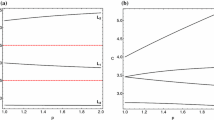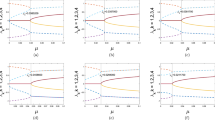Abstract
A circular restricted three-body problem describes the motion of a test particle around two massive bodies in circular orbits. In this system, orbital decay caused by a gravitational radiation reaction between the two primary bodies is considered but the direct effect of gravitational radiation on the test particle is neglected. We adopt distance- and time-scale transformations to Newtonian problems so that systems without orbital decay will not depend on separation between the primaries but systems with orbital decay will depend on this separation. If a regular or chaotic orbit is given in a Newtonian system, the starting separation of the primaries varies according to the corresponding decay system. Thus, insights into the chaotic behaviour of a third body in a decay case are provided. For a large initial separation between the primaries, the chaos that exists in a Newtonian problem may be retained for a long enough time scale of dissipative evolution before the primaries coalesce. The final state of a third body is escape attributed to orbital decay.






Similar content being viewed by others
Notes
Here are details of construction of the Poincaré section. At first, let us take a point \(P_1(X_1,Y_1)\) with \(Y_1<0\) at an \(i\)th step and another point \(P_2(X_2,Y_2)\) with \(Y_2>0\) at an \((i+1)\)th step. Then a linearly interpolating function of \(X\) on \(Y\) can be given by means of the two points \(P_1\) and \(P_2\). Finally, we obtain \(X\) from the function with \(Y=0\). In this similar way, we also have \(X'\) when \(X\) is replaced with \(X'\). Therefore, there is the point \((X,X')\) on the surface of section. Repeat the procedure as needed until many points can be plotted.
The formal definition of the Lyapunov exponent requires computation of the maximum characteristic exponent of the Jacobian matrix in phase space; therefore, the distance norm is usually specified in a manner similar to that for the phase space tangent vector. However, the definition of distance in spatial coordinates is better than that in phase-space coordinates because the difficulty in different dimensions can be avoided and the construction of an invariant distance is easy, as claimed in [47]. In addition, \(d(0)\) in the variational method is usually taken as 1.
In this case, computation of the Lyapunov exponent does not end until \(\tau =10^{7}\).
References
Wu, X., Zhang, H.: Astrophys. J. 652, 1466 (2006)
Semerák, O., Suková, P.: Mon. Not. R. Astron. Soc. 404, 545 (2010)
Semerák, O., Suková, P.: Mon. Not. R. Astron. Soc. 425, 2455 (2012)
Wang, Y., Wu, X.: Chin. Phys. B 21, 050504 (2012)
Wang, Y., Wu, X., Sun, W.: Commun. Theor. Phys. 60, 433 (2013)
Suková, P., Semerák, O.: Mon. Not. R. Astron. Soc. 436, 978 (2013)
Levin, J.: Phys. Rev. Lett. 84, 3515 (2000)
Cornish, N.J.: Phys. Rev. Lett. 85, 3980 (2000)
Cornish, N.J.: Phys. Rev. D 84, 084011 (2001)
Apostolatos, T.A., Lukes-Gerakopoulos, G., Contopoulos, G.: Phys. Rev. Lett. 103, 111101 (2009)
Kiuchi, K., Koyama, H., Maeda, K.I.: Phys. Rev. D 76, 024018 (2007)
Kiuchi, K., Maeda, K.I.: Phys. Rev. D 70, 064036 (2004)
Wu, X., Xie, Y.: Phys. Rev. D 77, 103012 (2008)
Zhong, S.Y., Wu, X., Liu, S.Q., Deng, X.F.: Phys. Rev. D 82, 124040 (2010)
Seyrich, J.: Phys. Rev. D 87, 084064 (2013)
Wang, Y.Z., Wu, X., Zhong, S.Y.: Acta Phys. Sin. 61, 160401 (2012)
Huang, G., Ni, X., Wu, X.: Eur. Phys. J. C. 74, 3012 (2014)
Froeschlé, C., Lega, E., Gonczi, R.: Celest. Mech. Dyn. Astron. 67, 41 (1997)
Wu, X., Huang, T.Y., Zhang, H.: Phys. Rev. D 74, 083001 (2006)
Cornish, N.J., Levin, J.: Phys. Rev. D 68, 024004 (2003)
Levin, J.: Phys. Rev. D 67, 044013 (2003)
Wu, X., Xie, Y.: Phys. Rev. D 76, 124004 (2007)
Cornish, N.J., Levin, J.: Class. Quantum Grav. 20, 1649 (2003)
Hartl, M.D., Buonanno, A.: Phys. Rev. D 71, 024027 (2005)
Mei, L., Ju, M., Wu, X., Liu, S.: Mon. Not. R. Astron. Soc. 435, 2246 (2013)
Kokubun, F.: Phys. Rev. D 57, 2610 (1998)
Suzuki, S., Maeda, K.I.: Phys. Rev. D 61, 024005 (1999)
Chiba, T., Imai, T., Asada, H.: Mon. Not. R. Astron. Soc. 377, 269 (2007)
Wang, Y., Wu, X.: Commun. Theor. Phys. 56, 1045 (2011)
Valtonen, M.J., Mikkola, M., Pietilä, H.: Mon. Not. R. Astron. Soc. 273, 751 (1995)
Gültekin, K., Miller, M. C., Hamilton, D. P.: The proceedings of The Astrophysics of Gravitational Wave Sources, College Park, Maryland, 24–26 April, pp 135–140 (2003)
Iwasawa, M., Funato, Y., Makino, J.: Astrophys. J. 651, 1059 (2006)
Hannam, M., Husa, S., Brügmann, B., Gopakumar, A.: Phys. Rev. D 78, 104007 (2008)
Naoz, S., Kocsis, B., Loeb, A., Yunes, N.: Astrophs. J. 773, 187 (2013)
Battista, E., Esposito, G.: Phys. Rev. D 89, 084030 (2014)
Battista, E., Esposito, G.: 2014. arXiv:1407.3545 [gr-qc]
Wardell, Z.E.: Mon. Not. R. Astron. Soc. 334, 149 (2002)
Wardell, Z.E.: Mon. Not. R. Astron. Soc. 341, 423 (2003)
Gültekin, K., Miller, M.C., Hamilton, D.P.: Astrophys. J. 640, 156 (2006)
Galaviz, P.: Phys. Rev. D 84, 104038 (2011)
Schnittman, J.D.: Astrophys. J. 724, 39 (2010)
Seto, N., Muto, T.: Phys. Rev. D 81, 103004 (2010)
Huang, G., Wu, X.: Phys. Rev. D 89, 124034 (2014)
Peters, P.C.: Phys. Rev. B 136, 1224 (1964)
Murray, C.D., Dermott, S.F.: Solar System Dynamics. Cambridge University Press, Cambridge (1999)
Tancredi, G., Sánchez, A., Roig, F.: Astron. J. 121, 1171 (2001)
Wu, X., Huang, T.Y.: Phys. Lett. A 313, 77 (2003)
Tichy, W., Brügmann, B., Campanelli, M., Diener, P.: Phys. Rev. D 67, 064008 (2003)
Acknowledgments
The authors are very grateful to an anonymous referee for a long enough review report in which many good suggestions were given. This research is supported by the Natural Science Foundation of China under Grant Nos. 11173012 and 11178002.
Author information
Authors and Affiliations
Corresponding author
Rights and permissions
About this article
Cite this article
Huang, G., Wu, X. Dynamics of a test particle around two massive bodies in decay circular orbits. Gen Relativ Gravit 46, 1798 (2014). https://doi.org/10.1007/s10714-014-1798-8
Received:
Accepted:
Published:
DOI: https://doi.org/10.1007/s10714-014-1798-8




